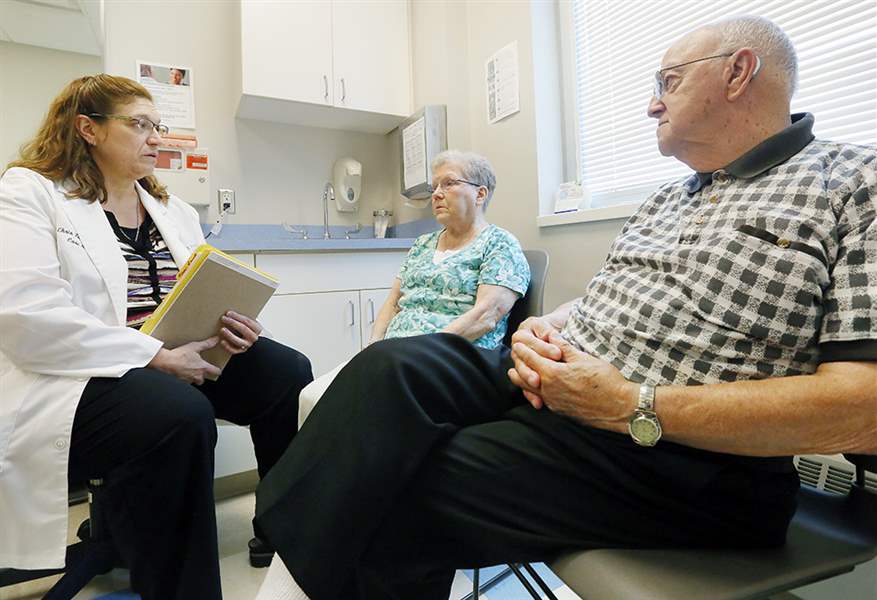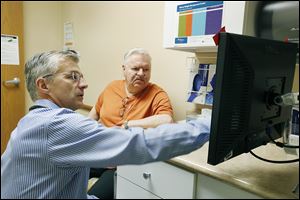
Obamacare transforms medical industry
Toledo’s health systems moving toward patient-centered model
8/31/2014
Chris Ludwig, RN Ambulatory CareNavigator at ProMedica Physicians Group, left, counsels Sherron Kern and her husband, Lowell Kern.
The Blade/Amy E. Voigt
Buy This Image

Chris Ludwig, RN Ambulatory CareNavigator at ProMedica Physicians Group, left, counsels Sherron Kern and her husband, Lowell Kern.
First of two parts.
Most agree that the Affordable Care Act, commonly known as Obamacare, has fundamentally changed the health insurance landscape in the United States, but the health-care law is also quietly causing a sea change in the way hospitals and doctors treat patients and do business.
“The entire industry is really doing a paradigm shift,” said Terri Thompson, vice president of population health for ProMedica.
Leaders at ProMedica and Mercy health systems, the two largest health providers in the Toledo area, are moving away from what they call an outdated model, where doctors get paid for each service provided, to a new one that is broadly known as population health management.
Health-care organizations and doctors are being pushed by the federal government to practice more preventative medicine, said Dr. Kenneth Bertka, vice president of physician clinical integration for Mercy.
“It used to be you just take care of the patient right in front of you and it was just one patient at a time. Now it’s about managing a community or a population of patients,” Dr. Bertka said.
The federal government is pushing the transformation by offering financial incentives for family practice doctors’ offices to serve as the hub of care for patients — and for doctors and hospitals to work closely together to keep patients healthy. The medical industry’s new term for the doctor’s office serving this role is the patient-centered medical home.
The new model would have the primary doctor serve as the head of the patient’s medical team — coordinating with any specialists who are also treating the patient — and spending more time thinking about how to prevent patients from getting sick instead of treating them after they develop a chronic illness.
The Obama Administration announced last week an additional $35.7 million in Affordable Care Act funding to help finance construction of new health centers across the country that focus on this concept.
Various federal programs offer doctors and hospitals the opportunity to get paid a percentage of any money saved, if they can show the savings came from keeping people on Medicare and Medicaid healthy instead of waiting for them to get sick.
“Medicare keeps the first 2 percent and above that it’s 50-50. Millions of dollars will be split,” Dr. Bertka said.
Pay models
In Lucas County, some two-thirds of residents are on federal government health plans, either Medicare, which is primarily for senior citizens, or Medicaid, which insures those below the poverty line or on disability. As the largest insurance provider, the Centers for Medicare and Medicaid Services sets the rates that hospitals and doctors receive for services for the bulk of their patients, Dr. Bertka said.
“Traditionally when Medicare changes how they pay or how they operate, the other health insurances do the same thing; in fact we are already seeing that,” he said.

Dr. Mark Cockley confers with one of his patients, John Petty of Perrysburg, in his office in Swanton.
Dr. Bertka said getting paid to test and treat patients is still the dominant pay model but others have been developed by CMS. The pay-for-performance model, which means that doctors get paid some amount for good outcomes, or through shared savings, is a new way of paying doctors, he said.
Another payment model that is being used by CMS is called bundled payments — where a doctor or hospital gets a set amount of money upfront to pay for one condition, such as a knee replacement, he said.
“The bundled payment takes care of everything from the time you come into the hospital to 30 days after you go home — one price for everything they do,” Dr. Bertka said.
Hospital officials stressed that although reducing the cost of health care is at the heart of why CMS created these programs, there also are standards in place that hold doctors accountable and they must demonstrate patients are getting better care. The goal is lowering cost while improving the overall health of the country, Dr. Bertka said.
“The reason that Mercy got involved is that this is where medicine is going anyway,” he said. “The fee-for-service model is not sustainable so a change was needed.” Right now, participation in the CMS shared-savings programs is voluntary, but Dr. Bertka said he can foresee a day when the program will be mandated by the government.
“It’s better for a patient because the payment is no longer dependent on ‘I did this procedure or that procedure.’ It’s dependent on we did the whole thing and we did it well,” he said.
Care navigators
One program being used by ProMedica and Mercy to help manage patient populations and reduce health costs is care navigators. At ProMedica, registered nurses work either in hospitals or are embedded in physician offices to focus on giving special attention to high-risk patients with chronic diseases.
“High-risk patients are just about 5 percent of the total patient population but they make up the majority of the total cost of care so if you can affect them, as well as the medium risk, to keep them from becoming high risk, that’s what we are trying to do,” Ms. Thompson said.
Chris Ludwig is one of ProMedica’s 15 registered nurse-care navigators working in doctor’s offices. She started in 2009, when ProMedica rolled the program out as a pilot, but now she manages 60-100 high risk patients for doctors at River Road Family Physicians in Perrysburg.
“She is always there. If we need an appointment and they say we can’t have it until down the road, I pick up the phone and call Chris,” said Sherron Kern, who has been under Ms. Ludwig’s care since 2011. The 79-year-old Maumee woman has heart disease and diabetes. She and her husband, Lowell, rely on Ms. Ludwig to juggle appointments with three doctors and to help regulate all of the medications she uses to stay healthy.
Ms. Ludwig said she recently averted a trip to the hospital for Mrs. Kern when her heart condition caused her take on extra fluid in her body. Mrs. Kern said she was dizzy, couldn’t breathe well, and had stomach pain.
“She called and right away I was able to speak to Dr. Evans who made some adjustments to medications, which began the process of getting rid of that extra fluid. That started on a Tuesday or Wednesday and by the weekend her weight had dropped,” Ms. Ludwig said.
Mr. Kern said he and his wife depend on the care navigator and have developed a close friendship with her.
“I just told Dr. Evans that any doctor that doesn’t have somebody like her available is being cheated because she saves them so much time and they come in with so much good information. They don’t have to start quizzing you when they get in the door,” Mr. Kern said.
Prescriptions
Many older Americans with health issues take multiple pills on a daily basis. One of the keys to getting health-care costs under control is making sure patients are taking the right pills, at the right time, and that doctors don’t unknowingly give a patient medication that will interact badly with something they are already taking, Dr. Bertka said.
“In terms of all Medicare admissions [to hospitals], some people think up to a third of them — and that may be a conservative estimate, so upwards of 33 percent — are related to medication. That number rises to 50 percent for re-admissions. Some are errors, some are duplication, some they didn’t get the medicine,” Dr. Bertka said.
He said to better address this problem, family practice doctors affiliated with Mercy now have staff call patients within 24 to 48 hours after discharge to see if there are any issues.
The 2009 Health Information Technology for Economic and Clinical Health Act, which became law before the Affordable Care Act, is what drove the health records adaptation by the medical community. “The Affordable Care Act did some things to accelerate it, but it was already a work in progress,” Dr. Bertka said.
He said Mercy’s system, MyChart, connects all Mercy doctors and medical facilities and tracks patients’ medical procedures and medications in one place. ProMedica also uses electronic record systems: McKesson in its hospitals and Allscripts in its physicians’ offices.
Dr. Mark Cockley, who runs Mercy Primary Care Associates in Swanton, said having health records of patients in an electronic form has been a huge move forward in identifying those high-risk patients and helping him manage their care.
However, this advance in medicine came with a hefty price tag. Hospital systems have spent hundreds of millions of dollars for software programs and many doctors in private practice have struggled to comply with the federal mandate to convert to electronic record-keeping.
Dr. Cockley said one of the reasons he changed from private practice to join Mercy back in 2010 as a salaried employee was the opportunity to use Mercy’s electronic system at an affordable cost.
The electronic health records allow his office to do quick assessments of patients, quietly in the background, each time they make contact with the office, such as calling in for a prescription refill.
“Previously the person would call — they would go find the chart. It was a lot more labor intensive thing, where now while I’m reviewing their request for a refill of medicine I can look and see they were just here two months ago, was their blood work done, and was it all normal. If we’re good I can refill that medicine having confidence they are at adequate therapy,” Dr. Cockley said.
Dr. Cockley said his office recently sent out 885 letters to patients reminding them it’s time for their annual mammogram — which he could not have done with the old paper record system. He also can generate weekly or monthly reports that help him keep track of high-risk patients such as people with diabetes.
“The big-time pressure is fitting all this new stuff in. It’s trying to find ways to make the rest of the day quicker, getting things more efficient, educating the other clinical staff to be able to do more things,” Dr. Cockley said.
He said the adoption of technology into his practice will eventually help him benefit from the shared savings the federal government is offering Mercy hospitals and its 430 affiliated physicians. He said that money has not flowed back into his practice yet.
“The goal with government when they said ‘you do this and we’ll give you these tax benefits, we’ll give you shared savings’ they put the carrot in front of the doctors — that carrot seems like it’s still out there — it’s like that mountain in the distance, you see and you walk towards but it still seems like it’s just as far away,” Dr. Cockley said.
Contact Marlene Harris-Taylor at: mtaylor@theblade.com or 419-724-6091.